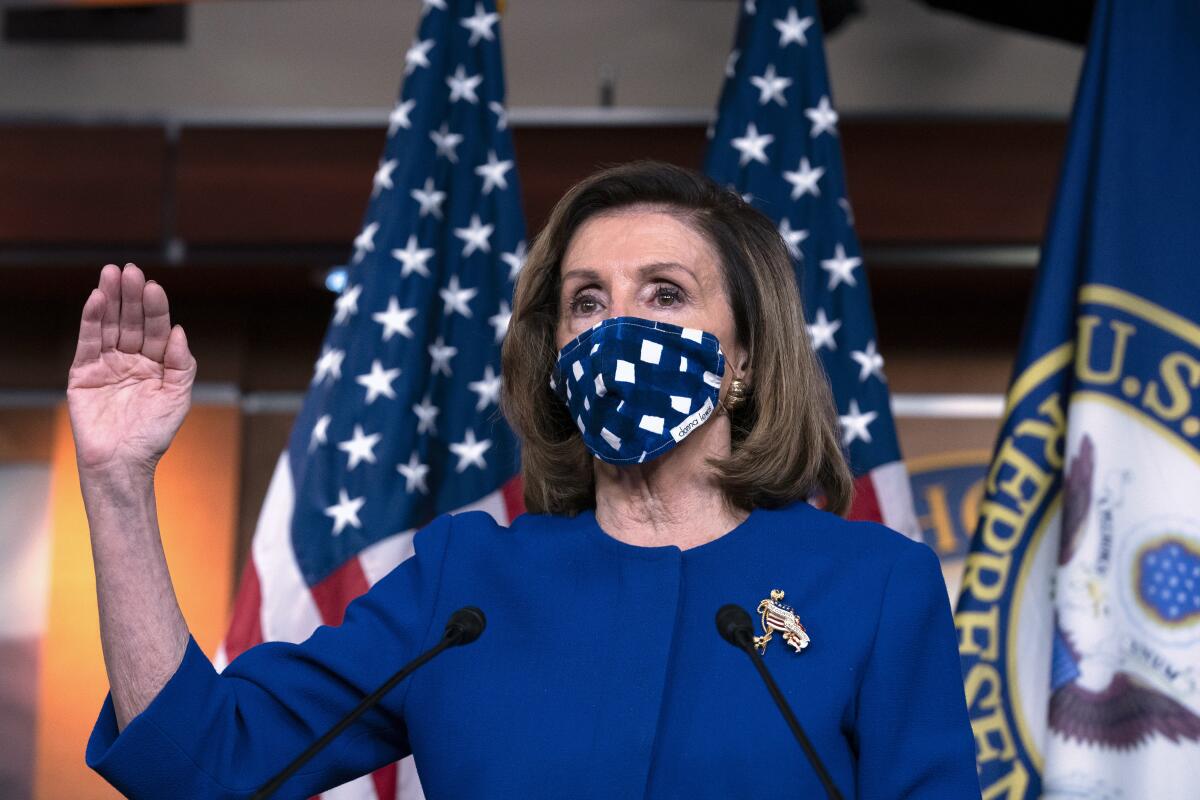President Pelosi? Odds are low, but here’s how it could happen

- Share via
WASHINGTON — It isn’t likely, but what happens if neither presidential candidate receives the required 270 votes in the electoral college, and the House of Representatives — for the first time in nearly 200 years — was left to pick the country’s next president?
The House has decided only two elections in U.S. history — in 1800 and 1824 — but this year a tie is a realistic enough scenario that both parties are doing what they can to have an edge, should it come to that.
House Speaker Nancy Pelosi (D-San Francisco) raised the specter in a late September letter to colleagues. President Trump has talked about it at his rallies.
“When you have the president of the United States who can’t even commit to a peaceful transfer of power, when you have the president of the United States who has hinted that he will not accept the results of this election, yeah, we’re looking at all the scenarios. Absolutely,” Democratic Congressional Campaign Committee Chairwoman Cheri Bustos said.
Why does a candidate need 270 votes in the electoral college?
Because that’s the system the founding fathers set up. Let’s do a quick review of how our country picks a president so we’re all on the same page.
When people vote for president in the general election they are actually voting for the slate of electors that represents a political party’s ticket. The founding fathers thought these electors — presumed to be educated, politically engaged citizens — would provide a bit of a check on the larger, uninformed masses to prevent a tyrant from getting elected.
This system is why we sometimes see a candidate win the electoral college vote and become president even though they lost the overall popular vote nationwide.
Once all the direct votes from each state are counted — a process we know in California can take weeks — the electoral college meets at the end of the year — Dec. 14 this year — to cast votes. Electors are generally required to cast their votes for the candidate that won the state the electors represent, so it’s largely a formality.
There are 538 electors, so 270 votes are required for an electoral college majority. But it is possible that each candidate will get 269 votes, and, while it’s unlikely, it’s not entirely out of the question when you look at the electoral map.
What happens in a tie?
If no presidential candidate receives 270 votes, it triggers a “contingent election,” and the 12th Amendment tasks the newly elected House with resolving who the next president will be.
The House has picked the president just twice, to resolve the 1800 election — as any fan of the Broadway hit “Hamilton” can attest — and then in the 1824 election. The 1800 election was such a mess that Congress and the states passed the 12th Amendment, laying out a smoother process for how the president would be chosen in the future.
If the decision falls to the House, members are limited to picking only from among the top three finishers in the electoral college vote. (This was more common before political parties were really a thing.) So if only Biden and Trump win electoral votes, as expected, the House has to choose between them.
The Senate follows a similar method to pick the vice president if the electoral college deadlocks on that position. That’s happened just once, in the 1836 election.
That’s all good for Democrats, right? They control the House.
Actually no. In fact they are at a disadvantage right now.
Yes, Democrats control a majority of the total number of House seats and are expected to hold that majority next year. But under the 12th Amendment, the House does not vote on a president the way it would vote on a bill.
Instead there are special rules. Each of the 50 House delegations — which consists of representatives from every congressional district in that state — receives only one vote. So California, with its 53 House representatives, gets one vote, and Montana, with its one House representative, also gets one vote. And that vote is determined by the majority of the delegations.
So it could very quickly come down to red-state vs. blue-state math. And since Republicans tend to lead in many of the less-populated states, this would work to their advantage. While these figures may change after the November election, Republicans currently control a majority in 26 state delegations and Democrats hold a majority in 23 states. Pennsylvania is evenly split.
And unlike electors who have pledged to vote for the candidate that won their state, House members have not, so they are free to vote for the leader of their party, even if he or she lost their state.
What happens if a delegation can’t decide how to cast its vote?
If a state delegation is deadlocked, they aren’t counted as a yea or nay for either candidate, said Edward Foley, constitutional law professor at Ohio State University. In other words, if Pennsylvania stays 50-50 and everyone in that delegation votes for their party, the state’s vote may not be counted.
That could be a problem if no candidate can get 26 votes. The 12th Amendment is explicit that “a majority of all the states shall be necessary to a choice.”
If the House doesn’t make a selection by Inauguration Day on Jan. 20, the vice president as determined by the electoral college (or the Senate) becomes president until it does.
Oh, brother. What if the vice president hasn’t been picked?
If the electoral college is deadlocked on a president, there’s a chance it would deadlock on a vice president, too. In that scenario, the vice president is elected in the Senate through a separate, though slightly less complex process.
As with the House, the newly elected senators must select from the top vote getters in the electoral college. A quorum of at least 67 senators is needed. Then each senator gets one vote. A simple majority picks the vice president.
Let’s keep going down the rabbit hole: What if the Senate deadlocks or can’t get a quorum?
The Presidential Succession Act of 1947 states that if neither a president nor a vice president is selected by Jan. 20, the Speaker of the House becomes president until a president or vice president is picked. That would almost certainly mean, at least temporarily, President Pelosi.
Are the Biden and Trump campaigns mobilizing in case of a House showdown?
Somewhat. Republicans are working to shore up their lead in the number of states where they hold the majority of representatives in the House delegation, and Democrats are working to catch up. But flipping the balance of a state’s delegation isn’t easy, particularly when the nation is so divided and gerrymandering has left districts less competitive.
Many of the states whose House delegation includes comparable numbers of Democrats and Republicans — Florida, for example, has 13 Democratic House members and 14 Republicans — are already viewed as important swing states, so the campaigns are active there anyway.
Seven states have a single representative, which in theory would be easiest to flip. But most of them don’t have competitive races this year. Democrats are bullish about their chances in Alaska and especially Montana, where their 2018 nominee Kathleen Williams faces Republican state Auditor Matt Rosendale. But it’s a big hill to climb.
Democrats and Republicans are both defending vulnerable seats in the key swing state of Pennsylvania, so the 4-4 split in the delegation could remain.
Some point to Texas, which has a wider margin in its delegation, but where Democrats could make big inroads this year. Democrats need to win three of five heavily contested seats to deny Republicans a majority of the delegation.
More to Read
Get the L.A. Times Politics newsletter
Deeply reported insights into legislation, politics and policy from Sacramento, Washington and beyond. In your inbox three times per week.
You may occasionally receive promotional content from the Los Angeles Times.











